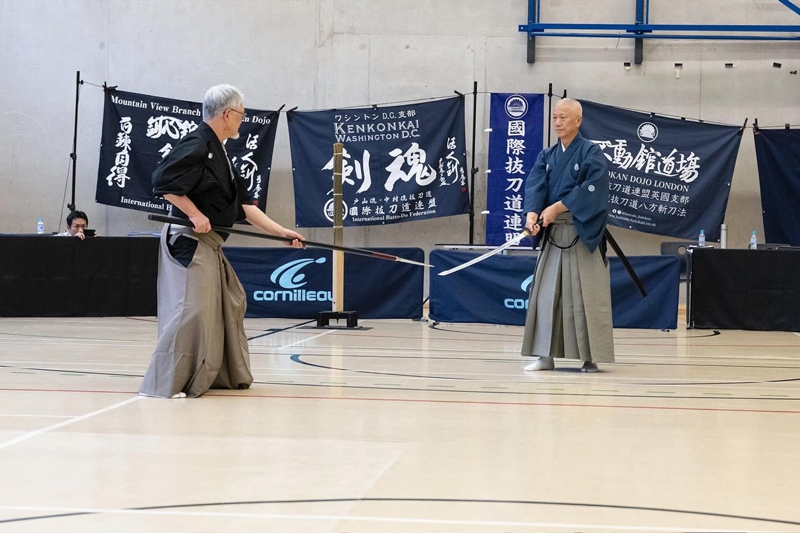A few weeks ago, at the end of March, Battodo Fudokan held an International Battodo Federation Taikai in London. Check this complete report by John Evans about the event that counted with international presences from 8 different countries:
Budoka from eight countries across four continents spent the last few days of March, 2024 training and competing together over a long weekend in London, UK as part of a Taikai hosted by the Fudokan Dojo and the International Battodo Federation. It had been well over decade since the last Taikai was held in London, and nearly 50 participants in total converged on the city to see friends old and new and take advantage of special training opportunities and the camaraderie of the Taikai itself.
The events of the weekend were overseen by six distinguished senior teachers from the International Battodo Federation. Yoshitaka Nomura, Hanshi 8th Dan, Hiromitsu Takano, Kyoshi 8th Dan, and Tsutomu Ishikawa, Kyoshi 7th Dan, came from Japan. David Drawdy, Kyoshi 7th Dan, and Carl Jenkins, 6th Dan, joined from the United States. And John Evans, Kyoshi 7th Dan, hosted everyone along with his students from the Fudokan Dojo.
The weekend began with a special day of training centred around the Nakamura Ryu Katana versus Yari (spear) kata. This set of six forms has rarely been taught outside of Japan, and everyone in attendance recognized how special it was to receive formal instruction in these kata from Nomura sensei and Takano sensei. Over the course of three hours, the sensei guided the group through both sides of all six forms, focusing on foundational elements like stance and the mechanics of the Yari itself, as well important details related to timing, distance, and targeting. To deepen students’ understanding of these forms, David Thatcher gave a presentation on Yari and armour, speaking for an hour about the how the evolving battlefield during the Sengoku period shaped the styles of armour, weapons, and combat. He brought along an impressive selection of real antique Yari and armour for students to handle, which deepened everyone’s appreciation for the kata they learned that day.

The second day of training, the day before the Taikai, was devoted to Tameshigiri practice and grading for those students who were ready to test for their next rank. Tameshigiri plays a central role in the curriculum of the International Battodo Federation, which places significant emphasis on realistic movement and use of the sword. Battodo practitioners strive to make every cut “real” whether or not a target is present. Nakamura Taisaburo sensei wrote, “…Iaido is still a martial art, and the original form was trained with cutting as its core principle... I would like for Iaido and Tameshigiri to be seen as two wheels on the same axle and wish for their practice to first and foremost address being able to cut.”
With this guidance in mind, a small army of Fudokan students volunteered to soak the more than 150 tatami mats required to support the weekend’s activities, which is no small logistical feat in a city like London. During the Tameshigiri session, students divided into groups based on their grade and teachers provided feedback and coaching while students practiced the cutting patterns they would be required to perform for grading or in competition the following day.

Each day of a Taikai weekend is long and demanding, but for different reasons and in different ways. The two days of training prior to the Taikai require practitioners to pace themselves, absorbing as much as they can across four to six hours of daily training without becoming exhausted. The Taikai is an entirely different kind of challenge. Although the day is long, lasting from about eight in the morning until five in the afternoon, each individual only competes with sword in hand for a total of about 10 minutes throughout the entire day. And so the Taikai is a true test of one’s ability to “switch on,” to go from the everyday mind to the budo mind, or even the combat mind, depending on the event. It’s difficult to reproduce this unique atmosphere during regular training in the dojo, which makes Taikai and grading all the more important.

This year’s Taikai featured competition in individual kata and Tameshigiri (in two divisions based on level of experience), Kumitachi, and team Tameshigiri. The day was punctuated by a midday demonstration by all of the teachers who shared exemplary performances of kata, Kumitachi, and Tameshigiri from the Nakamura Ryu curriculum. Senior students from Fudokan Dojo also demonstrated the Tanren (conditioning curriculum) and kata of Kurikara Ryu Heiho, which is also part of the dojo’s unique curriculum under Evans sensei. The program made for a truly special experience for the dozens of guests watching the day’s events from the sidelines.
Across every event, competitors conducted themselves with great respect, friendship, and spirit. While everyone comes to a Taikai for their own reasons, two common themes are consistent across years and locations. The first is a desire to test oneself under pressure — to see what one is able to achieve on command. The second is the Battodo community itself, drawn together by a shared love of this wonderful budo, the culture it comes from, and the people who practice and preserve it.

After three days of fantastic training and spirited competition, all of which ran like clockwork thanks to the efforts of the Fudokan Dojo and the generous spirit of teachers and students alike, the unofficial motto of the International Battodo Federation remains as true as ever:
“Have sword, will travel.”

